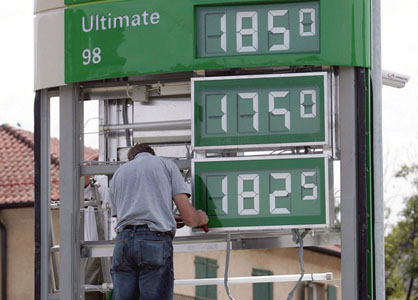Oil prices not yet at Swiss pain threshold

Experts say Switzerland has not yet reached its pain threshold in terms of oil prices even though they are hovering just below the $100 (SFr113) per barrel level.
US crude for December delivery stood at $96.23 a barrel on Friday morning, reversing the previous day’s 91-cent drop but down on its record high of $98.62 earlier in the week.
Abdullah al-Badri, the secretary-general of Opec, the group of oil-producing countries, has called for tighter regulation of the oil markets to counter the speculative investment it blames for the situation.
Overall prices have risen by 60 per cent this year.
“With the current volatility [$100] might be easily reached but we do not think that this is a sustainable level… we rather think that the price will come down soon afterwards,” Eliane Tanner, an analyst at Credit Suisse, told swissinfo.
Tanner said the weakening dollar had pushed crude oil prices higher. “Moreover the market is tightening and we have seen declines in crude oil inventories which have also supported crude oil prices,” she explained.
“The third thing was the geopolitical situation at the Iraq-Turkey border which is not resolved yet.”
Rolf Hartl, director of Swiss Oil Association, which represents the oil business in Switzerland, also foresees the possibility of prices “climbing the $100 ladder”.
Increasing demand
“The demand is still increasing even with such high oil prices, but the offer is quite limited due to the production policies of the oil countries, especially the Opec counties,” Hartl told swissinfo.
“So there is a narrow gap between offer and demand and this stimulates investors [who] are now rushing to oil… to compensate the declining value of the US dollar. Commodities, especially oil, are a very good alternative.”
As for the effect on Switzerland, Hartl said that the situation had dramatically changed since the 1970s, when the country was hit by two oil crises.
“Our economy can bear these high oil process because the oil and energy prices make up only around four per cent of Swiss household expenses. This figure was significantly higher in the 70s. We are now not so dependent on the oil price,” said Hartl.
Pump prices
Consumers also seem to be weathering higher petrol charges. Hartl said over the past few years petrol and diesel consumption had actually increased by one per cent despite higher prices at filling stations.
“In Switzerland this pain threshold has not been reached yet,” he said.
Earlier this month several companies, including BP, Shell and domestic company Migrol, increased their petrol and diesel charges by up to three centimes, according to a survey by the Associated Press.
On average petrol costs are still below SFr2 per litre in Switzerland. This is lower than most other European countries, says Swiss Oil.
Not immune
Hartl warned, however, that the Swiss economy was not totally immune to oil concerns because of its dependence on global markets.
“Every second Swiss franc is earned on foreign markets and if high oil prices pushed the global economy into a recession then the Swiss economy would also be a victim,” he told swissinfo.
Both Tanner and Hartl do not expect the high prices to continue indefinitely, with Hartl predicting a “massive reversal” in the medium term. However, Credit Suisse believes that the market could tighten again in late 2008.
swissinfo, Isobel Leybold-Johnson
The main oil-producing countries are Saudi Arabia, Russia, the US, Iran, Mexico and China. Opec accounts for around 42% of global oil production, according to the Federal Energy Office.
Around two-thirds of Swiss oil imports are finished products with the rest being crude oil. Most crude oil imports come from Africa, while finished products come from the EU.
The two oil crises in the 1970s underscored Switzerland’s high dependency on one energy source. It therefore reduced the proportion of oil products to overall energy consumption from around 80% (1973) to 56.5% (2005) (25.4% for combustibles, 31.1% for motor fuels).

In compliance with the JTI standards
More: SWI swissinfo.ch certified by the Journalism Trust Initiative



You can find an overview of ongoing debates with our journalists here. Please join us!
If you want to start a conversation about a topic raised in this article or want to report factual errors, email us at english@swissinfo.ch.